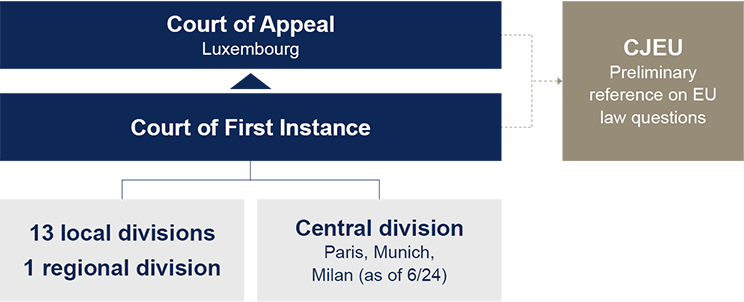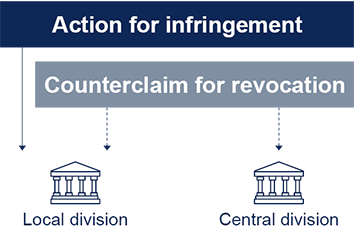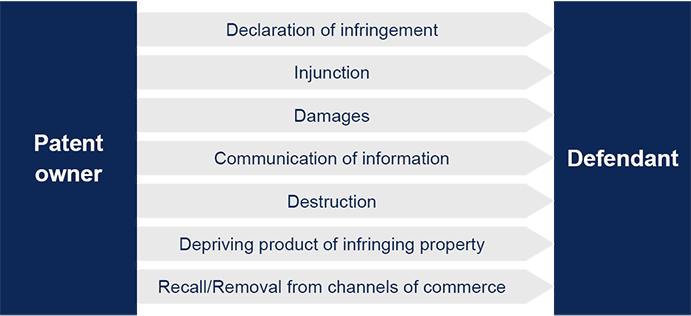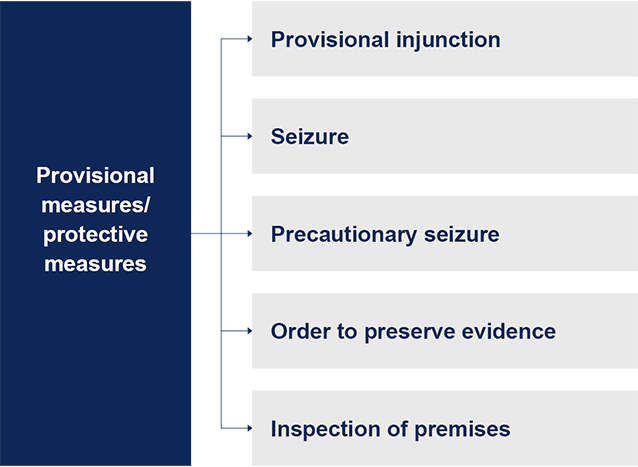Since the launch of the European Unitary Patent system on 1st of June, 2023, Gleiss Lutz has been successfully representing clients in patent disputes before the Unified Patent Court (UPC). Our team was involved in one of the UPC’s first landmark judgments (on opting out). UPC case law will form the basis for a new uniform patent system in Europe – with the German local divisions anticipated to assume a pivotal role.
The first rulings show that, alongside the substantive aspects of patent law, questions surrounding civil procedural law are prominently contested. Our experienced patent law specialists are ideally placed to navigate clients through UPC litigation. Their expertise is also demonstrated by the authoritative European Patent Litigation handbook (Handbuch Europäischer Patentprozess) by Bopp/Kircher (published by C.H. Beck), which they co-authored.
On which matters does the UPC have jurisdiction?
The UPC is a supranational court in which currently 18 (with prospects of expanding to 24) EU Member States are currently participating. It was established by the Agreement on a Unified Patent Court (UPCA), which was concluded between the majority of EU Member States.
The UPC has jurisdiction for “European patents”. That includes exclusive jurisdiction for the new unitary patent (European patent with unitary effect, UP) as well as, at the option of the patent owner, for the classic European patent (EP), which is broken down into a bundle of national patents upon grant.
The UPC in principle decides on all types of proceedings known from national patent disputes such as infringement actions, provisional injunction proceedings, evidence preservation measures and inspections, actions for declaration of non-infringement and actions for revocation. Its decisions apply in all participating Member States. In addition, the UPC is granted “long-arm jurisdiction”, i.e. under certain conditions it can decide on the infringement of an EP in an EPC Member State that is not participating in the UPC system.
The transitional regime for European patents – UPC or opt-out?
A transitional regime applies to classic bundle patents until (at least) 2030:
- In case of a bundle patent, the owner can generally choose whether to take action before a national court or the UPC. Conversely, actions for revocation can also be brought either before the national courts or the UPC.
- Unless an action has been brought before the UPC, patent owners can choose to opt out. In this case, the national courts will continue to have exclusive jurisdiction until the end of the transitional period.
- Patent owners can withdraw such an opt-out at any time unless an action has been brought before a national court before or after the opt-out. In the latter case, the opt-out becomes irrevocable which means that the EP is permanently excluded from the jurisdiction of the UPC.
- If an EP was – even before the launch of the UPC – the subject of national proceedings in a Member State of the UPCA, patent owners should in any case not declare an opt-out if they wish to reserve the right to enforce the EP in the UPC.
Where are the locations of the UPC and how is it structured?
The UPC has two instances. The Court of First Instance has a decentralised structure, comprising local/regional divisions on the one hand and the central division on the other. Its decisions are subject to review by the Court of Appeal, situated in Luxembourg.

The UPC can refer questions on the interpretation of EU law (e.g. on the Unitary Patent Regulation (EU) No 1257/2012) to the Court of Justice of the European Union.
In the vast majority of infringement proceedings, the Court of First Instance’s local divisions or its regional division have jurisdiction. There are currently 13 local divisions in 10 different countries, four of which are in Germany (Düsseldorf, Hamburg, Mannheim, Munich). At present, the only regional division is the Nordic Baltic Regional Division with transnational locations in Sweden and the three Baltic states. The jurisdiction of the local and regional divisions is primarily linked to the defendant’s seat or the place where the patent infringement occurred. The rules on jurisdiction are indeed quite complex and give rise to interesting forum shopping opportunities for plaintiffs.
The central division, with its sections located in Paris, Munich and (from June 2024) Milan, has jurisdiction for isolated revocation actions.
What is the composition of the panels of judges?
Local and regional divisions are generally composed of three legally qualified judges. A technically qualified judge may be added upon request by one of the parties or by the division on its own initiative after having heard the parties.

The request for the addition of a technically qualified judge can also be made in a protective letter. The judges are of different nationalities, but each of the German local divisions includes two German judges.
The central division is generally composed of two legally qualified judges and one technically qualified judge.

The Court of Appeal is generally composed of three legally and two technically qualified judges.

What is the language of proceedings?
As a rule, proceedings before the local divisions are conducted in the language of the Member State in which the local division has its seat. In addition, English is accepted as a language of proceedings at all local divisions. The language of proceedings in the Nordic-Baltic Regional Division is also English.
The language of proceedings conducted before the central division is the language of the patent in suit.
Proceedings before the Court of Appeal are conducted in the same language as the proceedings in the first instance. If the parties agree accordingly, the appeal proceedings can also be conducted in the language of the patent.
How do infringement proceedings before the UPC work?
Proceedings before the UPC are subject to a tight schedule set out in the Rules of Procedure, the aim of which is for an oral procedure to be held around one year after the action was filed and for a decision to be reached shortly afterwards.
The proceedings can be divided into three phases:

During the written procedure, the parties present the matter in dispute in accordance with fixed deadlines. The time limit for submitting a statement of defence is three months. Subsequently, the plaintiff has two months to reply. The deadline for the defendant to submit a rejoinder is one to two months, depending on the situation. The deadlines for a possible revocation counterclaim by the defendant and a request for amendment/limitation of the patent by the patent owner are synchronized with the aforesaid schedule.
The written procedure is followed by an interim procedure, which serves a dual purpose: it facilitates preparations for the oral hearing and fosters an environment for settlement negotations between the parties. This may encompass an optional interim conference which is preferably conducted by telephone or video conference. The interim procedure is led by the judge-rapporteur.
The final stage of the proceedings is the oral hearing, which is conducted by the presiding judge. The court is required to issue its decision in writing within six weeks after the oral hearing.
Unitary or bifurcated system?
In contrast to the bifurcated system of the German law, the UPC has jurisdiction to rule on both the infringement and validity of a European patent (unitary system). It has the power to revoke a European patent, in whole or in part, with effect for all participating Member States. If both the infringement and the legal validity of a patent are in dispute (which is regularly the case), the following scenarios are possible:
- If a revocation counterclaim is brought during ongoing infringement proceedings, the local or regional division dealing with the matter can decide on the infringement action and the counterclaim together – after a technically qualified judge has been added, if necessary. Alternatively, the local/regional division can refer the counterclaim to the central division and suspend the infringement proceedings. With the agreement of the involved parties, the local division may also refer the entire dispute to the central division. The local/regional division has discretion how it manages the proceedings. As a rule, the local/regional division decides on both aspects – infringement and validity – on its own.

- Conversely, if an isolated revocation action is pending before the central division, the patent owner can decide where to bring an infringement action. The infringement action can be lodged either at the central division or at any competent local/regional division.
The Court of Appeal decides on both infringement and revocation aspects of the dispute.
Taking the evidence – what principles apply?
The UPC combines elements of Anglo-Saxon and continental European litigation, but does not provide for discovery. Rather, it is up to the party bearing the burden of proof to obtain and present suitable evidence. However, the parties should make more extensive use of evidence, such as expert reports, technical reports and written witness statements (affidavits), than is customary in national proceedings before German courts. The UPCA also provides for a shift of the burden of proof in certain cases. In addition, the court may order that evidence be presented if the opposing party or a third party has control of the evidence. There is also a procedure for preserving evidence and for inspecting premises that is closely modelled on the French saisie-contrefaçon and can also take place ex parte, i.e. without the opposing party having been heard.
Enforcement objectives – what can be achieved before the UPC?
The range of enforcement measures available in infringement proceedings essentially corresponds to the standard that has been laid down by the Enforcement Directive throughout the EU since 2008. The most important legal objectives are injunctions, orders requiring the infringer to provide information, and damages. Additionally, the court may also order the destruction, recall or definitive removal of the infringing products from the channels of commerce.

Conversely, the most important defensive measures are the declaration of non-infringement of a patent (negative declaratory action) and the revocation of a patent.

Provisional measures and protective letters – what options does the UPC offer?
The UPCA provides for a differentiated system of provisional measures that are at the discretion of the UPC. In addition to a provisional injunction, the court can order the seizure or delivery up of products allegedly infringing a patent. The court can also order measures to preserve evidence, including an inspection, by way of provisional measures. The UPCA further provides for “precautionary seizure” of the alleged infringer’s property, encompassing (all) tangible and intangible assets including the possibility of blocking bank accounts.

The UPC can issue the aforementioned provisional measures of interim relief not only inter partes, but also ex parte, i.e. without the opposing party having been heard. To mitigate the potential risks of an ex parte order, parties may file a protective letter with the UPC. A protective letter remains on file for six months.
Conclusion
The UPC is rapidly developing a new substantive and procedural European patent law. There is no good reason to avoid bringing matters before the UPC, as it has very experienced judges and is itself interested in becoming a success. The decisions already rendered by the UPC are of high quality. Moreover, the UPC paves the way for strategic forum shopping opportunities and allows for the development of new enforcement strategies. Gleiss Lutz’s patent litigation experts are ideally placed to represent clients in proceedings before the UPC.
Your Contacts
News in patent law
Receive further information on mandates, developments and events in patent law here







